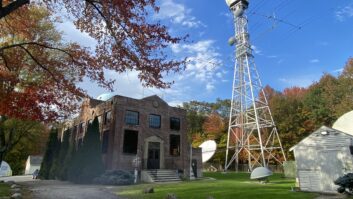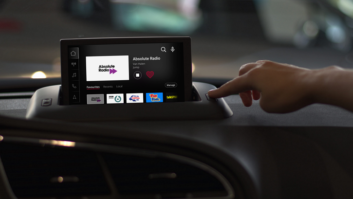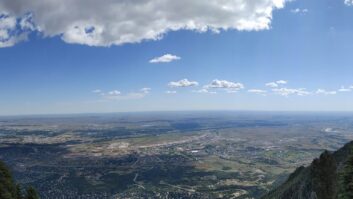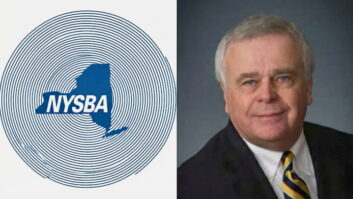Harry Reid’s FCC intervention is provoking new thinking on LPFM licensing and how more pirate stations might become legal.
In January, the Senate majority leader, a Democrat from Nevada, intervened with the FCC to allow an unlicensed pirate broadcaster back on the air. It was a breakthrough victory not only for pirates but for many who dream of owning and running their own radio station.
Radio Goldfield Broadcast Inc. is now fully cleared to serve a small Nevada desert community and parts of nearby Tonopah under special temporary authority, BSTA-20061206AFZ, with call letters KGFN-LP. Owner Rod Moses has moved his pirate operation from 100.3 to 106.3 FM with 100 watts and will use the STA until he can apply for an LPFM license in a future filing window. His mobile home station had been raided and shut down by the FCC last June.
LOUD AND CLEAR
Pressure from an influential politician has forced the FCC’s hand to set a new and potentially dangerous precedent here, legitimizing an illegal pirate operation.
FCC licensing rules and due process were completely circumvented to establish a new legal radio station. The action sends a loud signal to all varieties of pirates, including political and social activists as well as radio station owner wannabes everywhere.
Following Radio Goldfield’s lead, all they really need to do now is go on the air and contend that their programming is in the public interest – plus of course obtain the backing of local area friends and especially a key politician who can exert pressure on the commission. This could include legendary pirate stations like Radio Free Berkeley that have been battling the FCC for years, but also applicants of previously failed attempts for a legitimate LPFM license.
Radio Goldfield won this round with the government. The precedent paves the way for more up-start pirate operations like it to follow. This is particularly troubling for many, as the rules prevent former convicted pirates from being eligible to apply for LPFM stations. But the Radio Free Brattleboro decision in Vermont seems to have laid that prohibition to rest once and for all.
Other pirates who choose the “Goldfield waiver” route will certainly have to be measured by the same criteria to be eligible for legal conversion, if it stands. So far, there is no indication that it won’t.
If we do see an influx of copycat operators, increased interference will likely occur in more populated areas where open channels do not exist. The FCC is hardly equipped to deal with the extra burden of ramping up enforcement activity against more pirates. Affected stations may have to take it upon themselves to do the legwork of finding and identifying pirates to turn over to authorities. Many in south Florida are doing just that already.
THE GOLDFIELD EXPERIENCE
Licensing a new radio station in an underserved area like Goldfield, Nev., should not have been that difficult. There were numerous frequencies that could have been allocated for a fully licensed station in this sparely populated area about halfway between Reno and Las Vegas. But that path takes more time and money and now requires any new proposed channel to go up for auction. Moses was apparently not willing or prepared to take that risk.
An LPFM station was no doubt more appropriate for Goldfield but that filing opportunity was closed. Instead of waiting for a new LPFM window, Moses took the path of least resistance and established his pirate operation with good intentions while completely ignoring prevailing regulations.
The Goldfield case however is not the usual story of a pirate with a political agenda who breaks the law and defies the feds. Higher-profile pirates usually get busted and then return to the air at another location to keep broadcasting illegally. Some file suit and fight the FCC in court.
Moses apparently is not that kind of operator. His station was put on the air to serve his community with content attractive and important to its residents. His STA would have never been granted had he not co-operated with the FCC inspectors and made a compelling argument for the public service value of his local programming.
The Pahrump Valley Times reported the details of some of his local program offerings that convinced Sen. Reid and the FCC this service was worth fighting for. These are from Reid’s letter to the commission: “Radio Goldfield programming brought regular weather reports to this high-desert area of Nevada, where conditions can abruptly change in oftentimes dramatic ways … Radio Goldfield programming also included timely and reliable information on law enforcement, public safety and school activities that helped the residents of Goldfield stay informed and engaged in their community.
“Moreover the station broadcasted Sunday religious services that were listened to faithfully by those living too far from a place of worship or those simply too feeble to make a weekly journey there practicable.”
INSIDE THE BELTWAY BIAS
The process by which the commission awards LPFM construction permits and licenses simply does not accommodate the needs of the smaller more isolated communities. FCC rules treat the entire country without regard to population or proximity to large population centers and are written with an inside-the-beltway mentality. They essentially presume there are no populated areas left that deserve a radio station.
Instead, they assume many applicants will fight over scarce channels, probably resulting in MX proceedings. Thus all applicants are faced with very short and infrequent filing windows in all states.
There are literally thousands of small communities throughout this country like Goldfield that have no local service or that are woefully underserved by nearby broadcasters. In areas where LPFM stations can exist without causing interference, the rules should allow a more streamlined and simplified process by which operators like Radio Goldfield can become licensed.
LPFM applicants and operators of all kinds will need to be required to provide public service programming of value to their communities, just like fully licensed stations. Licenses should not be renewed unless licensees document and demonstrate such compliance at renewal time.
UNFULFILLED HIGH HOPES
Since its implementation in 2000, the entire LPFM experience has met with limited success, considering what its chief architect, former FCC Chairman Bill Kennard, had envisioned for it. Part of the LPFM disappointment has been driven by NAB lobby efforts that retain the third-adjacent channel protection rules, plus the delay in opening the LP-10 filing windows for 10 watt stations. Only 100 watt LP-100 licenses have been granted so far.
Some LPFM applications that serve significant population centers have been tied up in MX hearings. A few enterprising operators have licensed an LPFM to a “rim shot” bedroom community and then used clever, but often illegal means to translate the signal into the more populated area. The programming has little or nothing to do with the community of license and instead attempts to serve the nearby city, already served by many other stations.
The commission’s original intent for establishing LPFM was to provide unserved or underserved local areas with a new community-based, non-commercial public service voice. Local government, civic and educational groups were the obvious candidates.
Unfortunately there are many deserving groups within population centers that could benefit from an LPFM service but there are simply no channels that can be allocated without causing interference to existing licensees. FM subcarriers have been used over the years, mainly by ethnic broadcasters in large cities. But with the promise of more lucrative digital data services still looming, most of those are either unavailable or unaffordable. Leasing supplemental HD channels will likely prove to be no different.
Internet radio has rapidly emerged as the easiest method for such groups to establish their service. The advent of IP-based portable radios should begin to start augmenting the effectiveness of those services within the next few years. But there remain thousands of small communities where open channels are available that could benefit from a traditional LPFM service now.
MAKING ENDS MEET
Running successful, fully licensed community radio stations – both non-commercial and commercial – has long been a challenging endeavor, even in larger markets. Unless they are subsidized by an educational or governmental institution, most struggle to make ends meet every month despite the fact many staff members work as non-paid volunteers.
There are cases where community NCE stations survive by running foreign-language commercial programming in gross violation of the rules. When things run down technically, such stations are often the source of undesired interference to other non-commercial stations. The monthly bills for the usual leased office space, multi-studio facilities, STL and transmitter plant plus tower rental, all drain available finances quickly.
Every few months we hear of another community station raising the white flag, unable to stay alive financially and selling out, usually to a national religious group operator. That’s sad, since the losers are the local folks who are forced to look elsewhere for truly local programming of value.
RE-EVALUATING THE BASICS
Ever-advancing technology has dramatically changed the face of how American enterprise delivers information and entertainment and how it sells products. The Internet is only part of the revolution. Brick-and-mortar businesses everywhere are adapting to survive and prosper. Why not community radio?
The Goldfield story gives a decent example of how one individual put together a 100 watt station in his own home that delivers continuous programming of local interest to his community. It doesn’t take that much infrastructure and staff to build and run a modest but effective radio station nowadays. Pirates figured that out a long time ago.
Fully equipped control and production studios with expensive consoles, source equipment, full-featured automation and digital storage systems, processors and audio chains are no longer a necessity or even desirable. Plug a few Heil microphones into a Mackie mixer feeding a PC with Raduga automation software and you have a basic but affordable setup to launch good-quality audio. Even the audio processing can be a piece of inexpensive software. Add a second PC with an Internet connection and Adobe Audition for production needs and put the PCs on a simple LAN.
If you need an STL, use broadband or DSL Internet instead of expensive microwave or T1 circuits. A 100 watt transmitter with a decent-sized tower and a two-bay antenna is little more than a ham radio installation. Of course the exciter and transmitter will need to be FCC type-accepted to ensure occupied spectrum compliance. But you quickly see that such an installation would be easy to assemble and relatively inexpensive.
THE HARD PART
For many of the existing marginal operations to survive, scaling back expenses by downsizing to more modern and affordable, yet easier to manage facilities like I’ve described seems like a no-brainer. Managing the programming, staff, marketing and finances of a group-controlled operation will continue to be the real challenge.
Community radio with its usual collection of eccentric and demanding personalities often makes that very difficult and frustrating. I’ll leave the politics of making modest-sized community radio work and succeed in today’s environment to others. But significant relief could be gained by changing the rules to allow granting of LPFM licenses to individuals as well as groups to simplify control and management. That’s worked pretty well for all other classes of licenses.
Many LPFM observers and proponents have held that for the service to really prosper, the FCC will have to permit commercials. However, NCE and public radio stations everywhere have succeeded in exploiting and maximizing underwriting opportunities legally to produce revenue. The difference between commercial and non-commercial is not significant enough for LPFM to take on that battle and burden. It would subject the service to many more accounting headaches, including higher fees and taxes as a for-profit business.
The real question here is really not that hard: Why should so many smaller population areas go without local radio service because the bar of entry remains much too high? The old rules that support the old model as the only means of doing broadcasting in these vast United States should be re-evaluated carefully. Other countries have done it and succeeded.
Many areas could benefit from LPFM operations like Radio Goldfield where open frequencies are available. It’s time for the commission to seriously consider appropriate and easier methods to establish them legally. Issuing STAs under pressure from politicians is expedient but also bad public policy.






